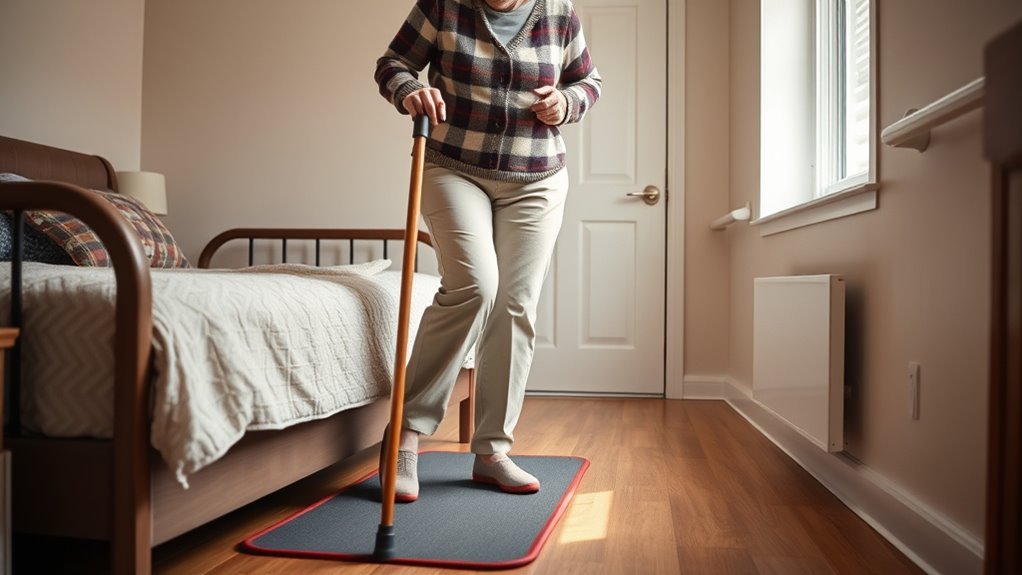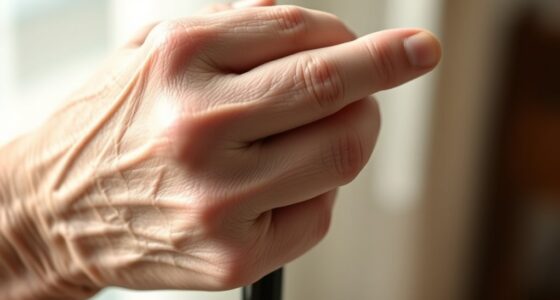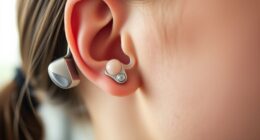To prevent falls, focus on home safety by removing clutter, adding grab bars, and ensuring good lighting. Keep your pathways clear and use non-slip mats on stairs. Take care of your feet by wearing supportive shoes and inspecting for issues. Stay active with exercises that improve strength and balance, and regularly evaluate your environment for hazards. Implementing these steps can greatly reduce your fall risk—continue exploring to discover more helpful strategies.
Key Takeaways
- Remove hazards like loose rugs, clutter, and cords, and ensure proper lighting to prevent trips and slips.
- Install grab bars and sturdy handrails in bathrooms and staircases for added support and stability.
- Wear well-fitting, non-slip shoes and regularly inspect feet for issues to reduce slipping and maintain foot health.
- Engage in balance, strength, and flexibility exercises to improve mobility and decrease fall risk.
- Conduct regular environmental assessments and adapt living spaces to changing mobility needs for ongoing safety.

Falls are a leading cause of injury among seniors, but many accidents can be prevented with the right strategies. One of the most effective ways to reduce fall risks is through home modifications. You should evaluate your living space and identify potential hazards that could cause trips or slips. Remove loose rugs, clutter, and cords from walkways to create clear, unobstructed paths. Install grab bars in the bathroom, especially near the toilet and shower, to provide extra support. Ensure that staircases have sturdy handrails on both sides, and consider adding non-slip treads or mats to prevent slipping. Good lighting is essential; replace dim bulbs with brighter ones and add nightlights in hallways and bathrooms to improve visibility during nighttime visits. These adjustments make your home safer and help you move around with confidence. Regularly assessing and updating your environment is also important to adapt to changing needs and prevent new hazards from developing.
Foot care is another critical aspect of fall prevention. Healthy feet support your balance and mobility, so you should pay attention to your foot health. Regularly inspect your feet for cuts, blisters, or signs of infection, and address any issues promptly with your healthcare provider. Keep your feet clean and moisturized to prevent dryness and cracking, which can lead to painful sores or infections. Proper footwear also plays a key role; wear shoes that fit well, provide good arch support, and have non-slip soles. Avoid walking barefoot or in slippers that lack grip, as these increase your chances of slipping. When shopping for shoes, get professionally fitted to ensure comfort and stability. If you experience foot pain or difficulty walking, consult a podiatrist for specialized care or orthotics that can improve your gait and balance. Taking good care of your feet not only helps you stay mobile but also reduces the risk of stumbling and falling. Additionally, stretching exercises can enhance flexibility and strengthen muscles that support your balance, further reducing fall risk.
Combining home modifications with attentive foot care creates a thorough approach to fall prevention. Your environment becomes safer, and your body becomes better equipped to maintain stability. Staying proactive by regularly assessing your living space and foot health can markedly lower your risk of falls. Remember, small changes—like securing loose rugs or wearing supportive shoes—can make a big difference. By taking these simple but effective steps, you can enjoy greater independence and confidence in your daily life. Fall prevention isn’t just about avoiding accidents; it’s about maintaining your quality of life and staying active for years to come.
Frequently Asked Questions
How Can I Improve My Vision to Prevent Falls?
To improve your vision and prevent falls, prioritize your vision health by scheduling regular eye exams. Follow your eye doctor’s recommendations and get updated prescriptions. Incorporate simple eye exercises, like focusing on distant objects or blinking frequently, to strengthen your eye muscles. Maintain good lighting at home and wear appropriate eyewear. These steps help sharpen your vision, making it easier to see hazards and stay safe.
Are There Specific Exercises for Strengthening Ankles?
Your ankles are the unsung heroes of stability! To strengthen them, try ankle circles, heel raises, and resistance band exercises regularly. Incorporate balance exercises like single-leg stands or heel-to-toe walks to boost your ankle strength and overall stability. These targeted ankle strengthening and balance exercises help prevent falls by improving your coordination and muscle control, keeping you steady on your feet and confident in every step.
What Should I Do if I Feel Dizzy Often?
If you feel dizzy often, you should sit or lie down immediately to prevent falls. Check if medication side effects might be causing your dizziness and consult your doctor about adjusting your meds. Also, make certain you stay hydrated, as dehydration risks can worsen dizziness. Avoid sudden movements and get up slowly from sitting or lying down. If dizziness persists, seek medical advice promptly to identify underlying issues.
How Can I Make My Home Safer for Falls?
To make your home safer for falls, focus on home safety by eliminating hazards like loose rugs, clutter, and electrical cords. Install grab bars in the bathroom, ensure good lighting throughout, and use non-slip mats on floors and in the shower. Keep pathways clear and stairways well-lit. Regularly check for hazards and fix them promptly. These steps help reduce fall risks and create a safer living environment for you.
Are Assistive Devices Effective in Fall Prevention?
Assistive technology, like grab bars and non-slip mats, can be highly effective in fall prevention. Fall detection devices, such as wearable alarms, provide quick assistance if you fall, reducing injury risk. These tools empower you to stay independent and safe at home. By using assistive devices and fall detection systems, you can substantially lower your chances of falling and respond promptly if an incident occurs.
Conclusion
By following these fall prevention strategies, you’re taking vital steps to protect yourself. But remember, falls can still happen unexpectedly—are you truly prepared for what might come next? Staying vigilant, keeping your environment safe, and maintaining your strength are ongoing efforts. Don’t let your guard down. The next time you step out of your door, ask yourself: could today be the day you prevent a fall? Stay cautious, stay safe—your well-being depends on it.









